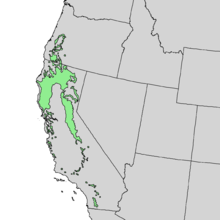| Quercus kelloggii | |
|---|---|

| |
| Scientific classification | |
| Kingdom: | Plantae |
| Clade: | Tracheophytes |
| Clade: | Angiosperms |
| Clade: | Eudicots |
| Clade: | Rosids |
| Order: | Fagales |
| Family: | Fagaceae |
| Genus: | Quercus |
| Subgenus: | Quercus subg. Quercus |
| Section: | Quercus sect. Lobatae |
| Species: | Q. kelloggii
|
| Binomial name | |
| Quercus kelloggii | |

| |
| Natural range | |
| Synonyms[1] | |
| |
Quercus kelloggii, the California black oak or Kellogg oak, is an oak in the red oak section (genus Quercus, section Lobatae, series Agrifoliae) native to western North America. Although genetically separated from them for more than 20 million years, its leaves (though not its fruit) are remarkably similar in appearance to several other members of the red oak section including the red oak (Quercus rubra) and the black oak (Quercus velutina) found in eastern and central North America.
- ^ "Quercus kelloggii Newb.". World Checklist of Selected Plant Families. Royal Botanic Gardens, Kew – via The Plant List. Note that this website has been superseded by World Flora Online
